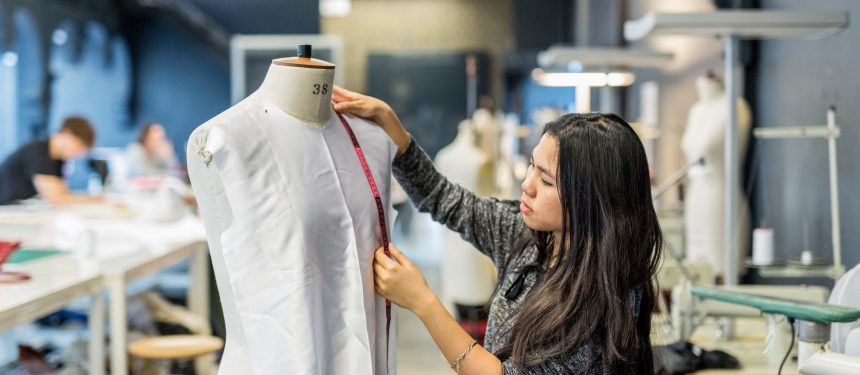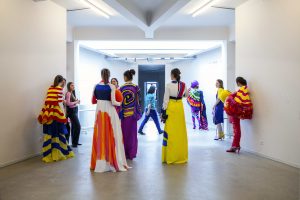The appeal of working in the fashion industry is at an all-time high. Thousands are pursuing dreams to become designers, retailers, marketers and even journalists covering the fashion sector, through fashion degrees.
News and business analysis for Professionals in International Education
Have some pie!
Fashion degrees sewing international seeds: A view from the runway
 Photo: Istituto Marangoni ISC student Muriel Jirom
Photo: Istituto Marangoni ISC student Muriel Jirom Ending up with Anne Hathaway’s job in ‘The Devil Wears Prada’ might not be what you had in mind, but finding your footing in the fashion industry can require more than vision, talent and a portfolio.
“Learning is the new trend,” says Danilo Venturi, dean of Polimoda – one of the top fashion schools in the world – at the school’s first Alumni Night event held in Florence, Italy.
According to the Council of Fashion Designers of America, fashion education has grown in the past 10 years and in some institutions, enrolments have tripled.
The McKinsey Global Institute states that the international fashion industry hit a total value of $2.4 trillion in 2016. It is the largest creative industry in the UK, worth £26 billion and 800,000 jobs, according to the UK Fashion and Textiles Association Manifesto 2012.
“It’s not just the ‘old’ European hubs that are the education centres to fashion students”
Fashion capitals like Milan, New York, Paris and London continue to attract the most students, but collaborations between existing universities and new study destinations are appearing.
Fashion education offers a real global choice, says Po Ingvarsson, an agent at Sweden-based Your Study Advisor.
LA came out on top, followed by Sydney, when Ingvarsson surveyed 100 high school students interested in fashion about their preferred study destinations. Not one student chose Milan.
“It’s not just the ‘old’ European hubs that are the education centres to fashion students,” he says.
Shopping for a fashion education
Universities and colleges offer a diverse range of fashion degrees, including different specialisations.
There has been a notable increase of interest for fashion business and marketing courses at the BA level, says Maria Setzu, director of student recruitment and international affairs at London College of Contemporary Arts in the UK.
On the international level, there can be a reliance on recruiting agents by both student and educator. Charlotte Ellison, media relations officer at the UK’s University for the Creative Arts, says the university has agreements with agencies in a number of countries such as China, Taiwan, Cyprus, India, Norway and South Korea.
“I would say that the recruiter job is a coaching activity,” says Setzu. “Choosing a school or a program is an investment for life.”
Chinese students are the largest international cohort studying fashion – and usually in the most traditional study destinations.
Will Wilbur, public relations manager at the New School’s Parsons School of Design in New York City, says the school had in prior years witnessed an increase in students from South Korea, but today the Chinese population has once again overtaken them.
Indonesia, India, US, UK, Russia, Germany, Spain, Italy, Sweden and France are also large source markets.
Vogue destinations
New countries are strongly competing for a share of the fashion-intent student crowd. Regional hubs are proving successful in attracting mobile students who prefer to stay closer to home, pay lower travel costs and study in a culturally familiar place.
In 2013, the UAE took steps to become a global fashion hub. In addition to several governmental decrees that will facilitate Dubai’s 2021 vision to convert the UAE into a “hub of fashion”, the first locally accredited fashion college in the Emirates welcomed its first students in February 2017.
College of Fashion and Design in Dubai is branded as a “niche institution” that will prepare graduates for a challenging work environment.
“The fashion field is just a sprout in Egypt, so we need five to 10 years to become like international fashion destinations”
Billa Bhandari, COO of CFD, explains that the school offers subjects in retail operations as part of its syllabus to meet a market need for trained talent with an understanding of retail operations.
CFD is not alone in the Emirates fashion education market. The UK’s Heriot-Watt School of Textiles and Design and France’s Esmod Dubai both offer different degrees in fashion and design in the UAE, while the University of the Arts London offers several short fashion-related courses in Dubai.
Stefania Gulina founded the Italian Fashion Academy in Cairo, Egypt in 2010, with the same vision to capitalise on a gap in the domestic market.
“I decided to stop in Egypt after pursuing market research and noticing there was no appropriate knowledge for whoever wanted to join the fashion field,” she says.
Students, mostly from the Middle East, Africa and Russia, tend to request one- or two-year courses, “which give you complete knowledge to become a fashion designer”, she says.
“The fashion field is just a sprout in Egypt, so we need five to 10 years to become like international fashion destinations,” Gulina adds.
Essential accessories
Traditional fashion colleges ensure industry partnerships and academic collaborations to provide more diverse study programs. International events, solid industry linkages and cross-border academic ties are essential to prepare graduates for work in the global market.
“There is an interest to sign collaboration agreements with schools in order to allow exchange study programs for students,” LCCA’s Setzu confirms.
Students spend a semester abroad and in some cases to start an undergraduate degree in one school and finish it in another. “Students can get different experiences and achieve double degrees,” she explains.
UCA’s Ellison says its ‘Study Abroad’ international exchange program receives the highest number of applications from students on fashion-based courses. The popularity indicates these students are globally focused and value international experience, she argues.
“Study Abroad has around 30 different partnerships with universities around the world for fashion and engages in student and staff mobility as well as collaborative projects,” she says.
Many colleges use cross-border collaborations to give students a global edge.
Italy’s Istituto Europeo di Design Spa has two joint summer courses with Paris College of Art and students participate in international fashion weeks in destinations including Moscow, Madrid and Tbilisi.
International projects such as ‘Two Ethos’, in collaboration with the Korean National University of Culture Heritage, mean students work on textiles recreated by KNUCH.
Marilyn McNeil-Morin, chair of the School of Fashion Studies at Toronto’s George Brown College in Canada stresses that industry relationships provide students with the opportunity to participate in industry competitions, to win scholarships and to network with industry professionals.
Students at Parsons in the US, for example, complete internships for academic credit during the semester or summer. “Students intern at top brands and fashion houses, such as Marc Jacobs, Alexander Wang and The Row among many others,” Wilbur says.
Prêt-à-porter
The rush for job placements start when students complete their final graduation collections.
An international certificate and “an expanded world fashion view” gives graduates an edge in the global industry
In the UK alone, there are 4,000 fresh fashion graduates annually and only 500 jobs. Globally, students compete for limited vacancies available in the fashion labour market.
“Students every day, more than before, enrol in a school or program and want to know where they can work, for which companies and how the school can link them to industry,” Setzu says.
But visa regulations can hinder postgraduate employment opportunities, according to UK providers.
In Canada, McNeil-Morin says international students who wish to stay can find employment to obtain their work visas, “and many are successful in this endeavour”.
If a students chooses to return home, an international certificate and “an expanded world fashion view” gives graduates an edge in the global industry, adds McNeil-Morin.
Schools and students must be open to different aspects of fashion, rather than the conventional design major. Courses like fashion business and media/marketing have emerged to better prepare students for the industry after graduation.
“Parsons and Eugene Lang College created a new major in 2014 called journalism and design, which blends elements of traditional journalism with graphic design, so that aspiring writers have the skills necessary to succeed in a constantly evolving media landscape,” relates Wilbur.
“To succeed in this industry, students have to stand out and think out of the box,” IFA’s Gulina says. “Fashion is more than drawing and sewing, you have to link it to everything in life.”
- This is an abridged version of an article that originally appeared in The PIE Review, our quarterly print publication.
Still looking? Find by category:





